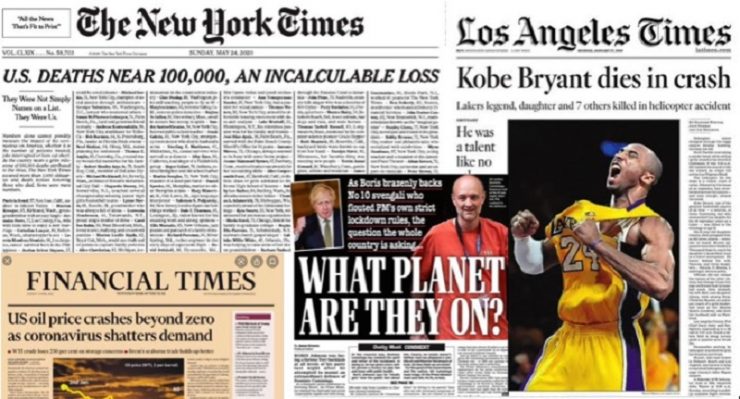DOES a good headline tell you its news content? We have heard the English idiom, popularized by Edwin Rolfe and Lester Fuller, “Never judge a book by its cover”, suggesting that you should not prejudge the worth or value of something by its outward appearance. In the case of a news report, and to answer the question, people will read further the news story based on its headline. Headline matters!
People no longer spend time to read the news. They would skim and skip reading news unless the headlines draw their attention. So, it is expected that headline tells the readers what the news story is about.
Traditionally, the headline is printed in large letters, placed at the top of the story. Its function is as the title of its story. With the competition going on between media, it is important that the headline is attention grabbing.
Put Your Creative Hat On and Create
There is a lot of creative thinking to be put before you decide on which headline works best for your news story. Remember you want to affect your readers with your headline.
Whether you want to create a headline for either one: your press release, news story, a feature, even a short story, your headline should be catchy, attractive and attention grabbing. If the headline is poor, the article will not be read, an article that is not read does not sell, the readers will only skip and move on to the next article.
Let me go straight to the point, so here are some of the Do’s and Don’ts when you create a headline:
Do’s
• Understand your readers first; as you want to attract the right audience, you know best what ticks them.
• Write the content first then write the headline; from the article you can see which can be highlighted in your headline -> fact, benefit, promise, or simply information. Example: “Red Wine And Aspirin May Fight Abnormal Cancer-Causing Cells.” – The Huffington Post.
• Explain what the story is about; remember to put the key words, so that your story appears in Google’s search (e.g. coronavirus). Example: “New Coronavirus Cases in the U.S. Soar to Highest Single-Day Total” – The Washington Post.
• Include the most important benefit, or the problem. Example: “Coloring Isn’t Just For Kids. It Can Actually Help Adults Combat Stress”. – The Huffington Post.
• Create a visual impact, to draw an emotional connection with the readers; make it dramatic, but not overboard and not far from the facts. For example use these words: ultimate, mind-blowing, horrifying, killer, incalculable. Example: “U.S. Deaths Near 100,000, an Incalculable Loss” – The New York Times.
• Use powerful action verbs for a more descriptive and more concise sentence. Byron Dobell, former editor of Esquire says: “A story is a verb, not a noun.” Never let your verb go missing in action. Example: “Nixon Resigns.” – The Washington Post.
• Use athletic verbs so that your readers can see what is happening in your story; for example: stampede, bounce, throttle, drive, trip, and more. Example: “Saturday Drive: Fiat 124 Spider Offers Classic Vibe”. – Forbes.
• Tell a story, write in the present or future tense; make your story immediate instead of historic. Example: “Facebook Tightens Controls on Speech as Ad Boycott Grows.” – WSJ Business.
• Create a loud, prominent and convincing message, this is to either persuade or make them believe in you. Example: “Social Media Taking Over The World”. – News Today.
• Be clever, but not too clever, remember who you are ‘talking’ to. A good and hilariously inappropriate example: “Where The Women You Hate Have Their Hair Done”.
• Use sexy verbs, only if your story can be described with it, and if it is aligned with the type of your story. Example: “Dirty Questions to Ask Your Boyfriend.”
• Short sentence, simple is clear; long headlines are not catchy enough. Example: “Men Walk On Moon”; “Voice From Moon: ‘Eagle Has Landed’” – The New York Times.
• Avoid ‘Public Relations/PR’ verbs often used by PR pros, which are already overused, for example: “Announces …”; “Launches …”; “Partners …”; instead use “Declares”, “Introduces”, “Collaborates with”.
Don’ts
• Give it all away in the headline; you want the readers to be curious enough to want to read the whole of your article. A good example: “Five Underrated Indonesian Cities To Explore After Bali.” – Forbes
• Form an opinion for the readers; it’s for the readers to decide and make their own opinion from your story. Example: “Was Bank Robber a He or She? Breasts might be a clue.”
• Do a confusing headline, again remember to whom you are ‘talking’ to. Example: “Forecasters Call For Weather On Monday.”
• Bury the verb, and you bury the story. Example: “Rooms With Broken Air Conditioners Are Hot”.
• Give a misleading headline, this is a big ‘NO NO’ or your future articles will never be read again, and they may even black list your name. Example: “Tiger Woods Plays With Own Balls, Nike Says”.
Just to get you back on track, crafting a catchy headline is an art, be creative, keep on practicing, write several different headlines and read them out loud, then decide which you think will work best for your article. Have fun! [by Ida Bayuni, Public Relations practitioner, bw communications – based in Jakarta]
















